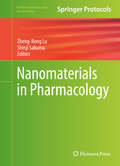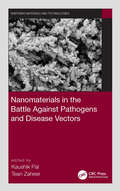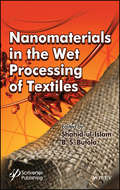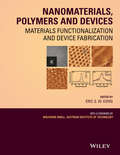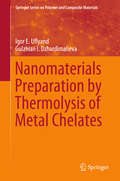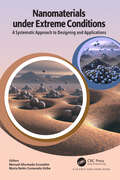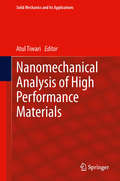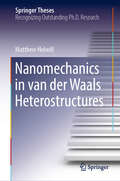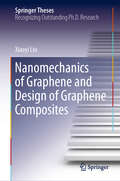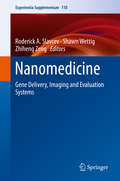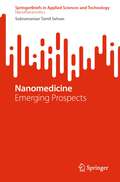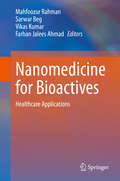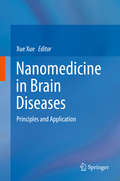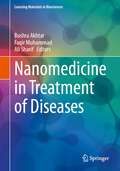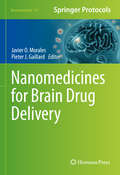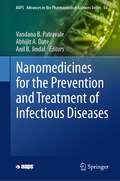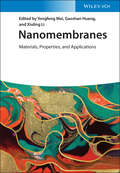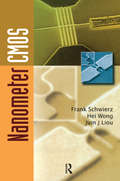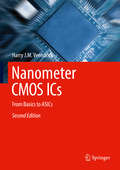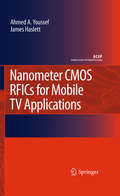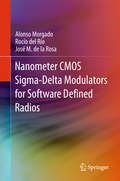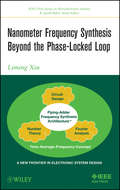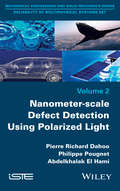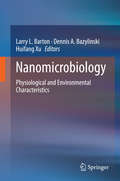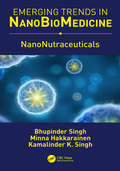- Table View
- List View
Nanomaterials in Pharmacology
by Zheng-Rong Lu Shinji SakumaThis detailed volume aims to introduce nanomaterials as a new therapeutic regimen in treating human diseases. Divided into four sections, it explores inorganic nanomaterials, organic nanomaterials, pharmaceutical properties of nanomaterials, and applications of nanomaterials in medicine. Several examples of inorganic and organic nanomaterials are provided to demonstrate how to design and develop nanomaterials for pharmacological purposes. The key pharmaceutical properties, including biocompatibility, tissue interaction, pharmaceutics, and pharmacokinetics of nanomaterials are discussed with a focus on the safety and pharmaceutical considerations of nanomaterials in translational development. The pharmacological applications of nanomaterials are depicted in treating various human diseases, including cancer, cardiovascular diseases, immune disorders, infectious diseases, gastrointestinal disorders, bone diseases, respiratory disorders, and drug delivery. Written for the Methods in Pharmacology and Toxicology series, chapters include the kind of specifics and practical advice that ensures a smooth transition into the lab. Authoritative and enlightening, Nanomaterials in Pharmacology serves as an ideal guide to researchers investigating the potential benefits and risks of nanomaterials in pharmacology in order to avoid the pitfalls and to maximize the potential of this vital field of study.
Nanomaterials in the Battle Against Pathogens and Disease Vectors (Emerging Materials and Technologies)
by Kaushik Pal and Tean ZaheerNanomaterials in the Battle Against Pathogens and Disease Vectors presents an overview of the use of nanotechnology to mitigate pathogens of concern, and is the first book to discuss applications of nanotechnology in the fight against all three major domains of disease-causing pathogens. Bacteria, viruses, and parasites constitute the list of emerging and re-emerging pathogens of high priority. Nanotechnology has proven to be a groundbreaking success in the elimination, targeted toxicity, precise immunogenicity, diagnosis, and imaging of these major pathogens and disease vectors. This text discusses basic concepts and advanced applications for bacteria, viruses, and parasites. It describes the use of metallic and non-metallic nanoparticles and nanotoxicity, as well as presents future applications of nanotechnology in biological applications. This work is ideal for engineers and scientists across the interdisciplinary fields of materials science, biomedical engineering, biotechnology, and others concerned with mitigating the risk and effect of pathogens.
Nanomaterials in the Wet Processing of Textiles
by Shahid Ul-Islam B. S. ButolaNanotechnology has attracted attention of textile and polymer scientists and has been playing extraordinary role over the past few decades in the functional finishing of different textile materials. Nanoparticles due to their diverse functions have not only imparted flame retardant, UV-blocking, water repellent, self-cleaning, and antimicrobial properties to the textiles, but also have greater affinity for fabrics leading to an increase in durability of the functions. This book emphasizes recent approaches and strategies that are currently at operation to functionalize both natural and synthetic textile materials using diverse nanoparticles and their composites with polymers. The book concludes by paying attention towards removal of toxic chemicals using state-of-the-art nano-adsorbents. Main Topics1. Textile dyeing using metallic nanoparticles2. Metal oxide nanoparticles for multifunctional finishing 3. New approaches to produce UV protective textiles4. Polymeric nanocomposites for antimicrobial finishing 5. Self-cleaning of textiles using advanced nanoparticles6. Silver nanoparticles in dyeing and finishing applications7. Zinc Oxide – prospects in textile industry8. Titanium dioxide: Next generation photo-catalysts9. Textile effluent using chitosan nanocomposites 10. Recent advances in remediation of textile effluents using nano-catalysts
Nanomaterials, Polymers and Devices
by Wolfgang Knoll E. S. KongProviding an eclectic snapshot of the current state of the art and future implications of the field, Nanomaterials, Polymers, and Devices: Materials Functionalization and Device Fabrication presents topics grouped into three categorical focuses: The synthesis, mechanism and functionalization of nanomaterials, such as carbon nanotubes, graphene, silica, and quantum dots Various functional devices which properties and structures are tailored with emphasis on nanofabrication. Among discussed are light emitting diodes, nanophotonic, nano-optical, and photovoltaic devices Nanoelectronic devices, which include semiconductor, nanotube and nanowire-based electronics, single-walled carbon-nanotube based nanoelectronics, as well as thin-film transistors
Nanomaterials Preparation by Thermolysis of Metal Chelates (Springer Series on Polymer and Composite Materials)
by Igor E. Uflyand Gulzhian I. DzhardimalievaThe book focuses on the thermal transformations of various types of metal chelates, e.g. low molecular weight and polymeric metal chelates, coordination polymers and metal-organic frameworks. It analyzes the major advances and the problems in the preparation of metal oxide materials, mixed-oxide nanocomposites, carbon materials and polymer derived non-oxide nanocomposites by the thermolysis of different metal chelates. It also highlights the influence of the spatial and electronic structure of metal chelates on the mechanism and kinetics of their thermal transformations, and discusses important issues like conjugate thermolysis and computer modelling of the thermolysis process. This book is useful for researchers experienced in thermolysis as well as for young scientists interested in this area of science.
Nanomaterials under Extreme Conditions: A Systematic Approach to Designing and Applications
by Manuel Ahumada Escand MarNanomaterials have supported humankind’s advancement, becoming one of the most important industry sectors, and are expected to rise to the top by 2030. However, significant challenges must be overcome, such as the performance and efficiency of the material under different environmental conditions. This book seeks to promote a critical view on using nanomaterials under extreme conditions found in our body, planet, and outer space. Therefore, nanomaterials are covered from multiple points of view, allowing the reader to get an enriching presentation of current knowledge on nanomaterials, limitations, advancements, and applications under extreme conditions.
Nanomechanical Analysis of High Performance Materials
by Atul TiwariThis book is intended for researchers who are interested in investigating the nanomechanical properties of materials using advanced instrumentation techniques. The chapters of the book are written in an easy-to-follow format, just like solved examples. The book comprehensively covers a broad range of materials such as polymers, ceramics, hybrids, biomaterials, metal oxides, nanoparticles, minerals, carbon nanotubes and welded joints. Each chapter describes the application of techniques on the selected material and also mentions the methodology adopted for the extraction of information from the raw data. This is a unique book in which both equipment manufacturers and equipment users have contributed chapters. Novices will learn the techniques directly from the inventors and senior researchers will gain in-depth information on the new technologies that are suitable for advanced analysis. On one hand, fundamental concepts that are needed to understand the nanomechanical behavior of materials is included in the introductory part of the book. On the other, dedicated chapters describe the utilization of advanced numerical modeling in understanding the properties of complex materials. I am sure that students and researchers from diverse backgrounds including chemistry, physics, materials science & engineering, biotechnology and biomedical engineering will find this book useful. It is well suited as a textbook for students and also as a reference book for researchers.
Nanomechanics in van der Waals Heterostructures (Springer Theses)
by Matthew HolwillMicro/nano-mechanical systems are a crucial part of the modern world providing a plethora of sensing and actuation functionalities used in everything from the largest cargo ships to the smallest hand-held electronics; from the most advanced scientific and medical equipment to the simplest household items. Over the past few decades, the processes used to produce these devices have improved, supporting dramatic reductions in size, but there are fundamental limits to this trend that require a new production paradigm.The 2004 discovery of graphene ushered in a new era of condensed matter physics research, that of two-dimensional materials. Being only a few atomic layers thick, this new class of materials exhibit unprecedented mechanical strength and flexibility and can couple to electric, magnetic and optical signals. Additionally, they can be combined to form van der Waals heterostructures in an almost limitless number of ways. They are thus ideal candidates to reduce the size and extend the capabilities of traditional micro/nano-mechanical systems and are poised to redefine the technological sphere.This thesis attempts to develop the framework and protocols required to produce and characterise micro/nano-mechanical devices made from two-dimensional materials. Graphene and its insulating analogue, hexagonal boron nitride, are the most widely studied materials and their heterostructures are used as the test-bed for potential device architectures and capabilities. Interlayer friction, electro-mechanical actuation and surface reconstruction are some of the key phenomena investigated in this work.
Nanomechanics of Graphene and Design of Graphene Composites (Springer Theses)
by Xiaoyi LiuThis book addresses several important issues concerning the nanomechanics of graphene, an area that is vital to a fundamental understanding of graphene deformation, and to the design of graphene-related materials. The content chiefly focuses on the out-of-plane mechanical behaviors of graphene, and their effects on the mechanical properties of graphene composites. In addition, the book puts forward original theoretical mechanical models based on continuum mechanics, discontinuous effects and atomistic simulations. The findings presented here can provide the basis for valuable guidelines on the design and application of graphene and graphene composites in the field of nanomechanics.
Nanomedicine: Gene Delivery, Imaging and Evaluation Systems (Experientia Supplementum #110)
by Roderick A. Slavcev Shawn Wettig Zhiheng ZengThis work was compiled to serve as a convenient source that covers a number of techniques (and details of their use) in the rather large field of nanomedicine, with special attention paid to gene delivery. As principal investigators working in the field of nanomedicine, we sought to put together the most current and relevant topics in gene delivery, imaging and evaluation systems. We expect the work to serve very well for scientists and graduate students in the nanomedicine field.
Nanomedicine: Emerging Prospects (SpringerBriefs in Applied Sciences and Technology)
by Subramanian Tamil SelvanThis book highlights the emerging paradigm of nanomedicine, intersecting two burgeoning fields of nanotechnology and medicine. Numerous publications have appeared in the literature over the years, especially in cancer nanomedicine. In a boarder sense, nanomedicine aims to apply the knowledge and tools of nanotechnology in a mission to diagnose early and prevent or treat diseases using biocompatible nanoparticles (NPs). Current research in nanomedicine and its prospects depend on creating new breakthroughs at the nexus of nanomaterials and biological systems, making use of non-toxic NPs and nano/biomaterials as smart theranostic systems for a variety of diseases including cancer, neurodegenerative, orthopedic, and cardiac diseases. This book provides a review on recent advancements of nanomedicine in the aforementioned emerging areas of nanomedicine.
Nanomedicine for Bioactives: Healthcare applications
by Mahfoozur Rahman Sarwar Beg Vikas Kumar Farhan Jalees AhmadNanotechnology is opening up new avenues in all scientific and technological fields. Among the novel applications, bioactives and nutraceuticals are fast-growing areas of nano research for better healthcare solutions. A variety of nanoformulations, such as polymeric nanoparticles, nanocapsules, nanoemulsions, transferosomes and ethosomes, liposomes, lipospheres, and lipid polymer hybrid nanoparticles have proved valuable in bioactive delivery and food materials. Further, new herbal drugs and nutraceuticals are reported to have remarkable advantages over conventional formulations of plant actives and extracts, including enhanced solubility, bioavailability, multiple drug delivery, greater stability, sustained delivery, improved tissue macrophage distribution, protection from toxicity, enhancement of pharmacological activity and protection from physical and chemical degradation. This book focuses on the advanced nanomaterials that are utilized for the encapsulation of nutrients/vitamin/phytoconstituents, as well as their other healthcare benefits.
Nanomedicine in Brain Diseases: Principles and Application
by Xue XueThis book provides an overview of the current applications of nanomaterials in brain diseases, and introduces several novel nanomaterials that have excellent potential in this field. During the last two decades, nanotechnology had matured significantly as it has transitioned from a bench-top science to an applied technology. However, the application of nanomaterials in basic and clinical neuroscience is still at an early stage, and understanding how the intrinsic properties of nanomaterials translate to complex biological responses is an area of intensive research. Part 1 of the book focuses on the principles and strategies of nanomedicine in the brain diseases, while part 2 examines the applications of promising nanomaterials for therapy and diagnosis in the brain. Together they offer a comprehensive picture of advances in nanotechnology and their successful use in treating brain diseases in the past 20 years.
Nanomedicine in Treatment of Diseases (Learning Materials in Biosciences)
by Bushra Akhtar Faqir Muhammad Ali SharifNanomedicine biotechnology is applied to and used to study drug development, working mechanisms, diagnosis, and therapies. This textbook particularly written for biomedical applications of nanomedicine covers the whole range of disease treatments related to nanomedicine. This book serves the purpose of highlighting the current advancements of nanomedicines-based regimens which may be employed in disease treatment while it also contains the fundamental knowledge for biomedical researchers from all levels. Each chapter starts with an introduction/theory into the specified approaches for various disease states followed by detailed discussions for a comprehensive understanding. This book best suits advanced level students, but also provides an excellent updated material for researchers and healthcare workers related to nanomedicine and diseases treatment.
Nanomedicines for Brain Drug Delivery (Neuromethods #157)
by Javier O. Morales Pieter J. GaillardThis volume explores the latest research in central nervous system (CNS) targeted nanocarriers, methods for their synthesis, and its characterization process. Chapters in this book cover topics such as polymeric nanoparticles and liposomes; self-assembled peptide-based scaffolds for lesions of the nervous system; use of peptides as CNS drugs and as potential carriers to optimize brain-targeted delivery; ways to model and assess blood brain barrier absorption of drugs; and the role of neurodegeneration progress of nanomaterials and their potential toxicity concerns. In the Neuromethods series style, chapters include the kind of detail and key advice from the specialists needed to get successful results in your laboratory.Thorough and cutting-edge, Nanomedicines for Brain Drug Delivery is a valuable resource that will help researchers guide and advance the field of nanomedicines for the brain and nervous system.
Nanomedicines for the Prevention and Treatment of Infectious Diseases (AAPS Advances in the Pharmaceutical Sciences Series #56)
by Vandana B. Patravale Abhijit A. Date Anil B. JindalThe COVID-19 pandemic has altered the world and reiterated the perpetual need for the development of effective strategies for the prevention and treatment of infectious diseases. While globally prevalent infectious diseases receive extensive attention in terms of drug development and delivery, the neglected and/or emerging infectious diseases that affect developing countries are often overlooked. Additionally, the therapeutic efficacy of existing anti-infective agents is often limited due to sub-optimal biopharmaceutical properties, sub-therapeutic levels of the drugs at the infection site due to various physiological barriers, the expulsion of the drug by efflux transporters, and the emergence of drug-resistant strains.From the commercialization of AmBisome® to the emergency authorization of mRNA-based vaccines, nanotechnology has played a vital role in the prevention and treatment of infectious diseases. More importantly, nanotechnology has enabled the effective utilization of existing armamentarium against infectious diseases leading to improved therapeutic outcomes with a concomitant reduction in the side effects associated with anti-infective agents. In particular, nanotechnology can bring about a paradigm shift in the management of neglected and emerging infectious diseases and may compensate for the lack of drug discovery efforts. While there are several books dedicated to pharmaceutical and/or biomedical applications of nanotechnology or nanotechnology for cancer therapy a comprehensive book focusing on the prevention and/or treatment of viral, bacterial, fungal, and parasitic infections is not available. This book addresses an unmet need in pharmaceutical and medical education.This book provides a comprehensive and up-to-date overview of the latest advancements in nanomedicine, which show great potential for preventing and treating infectious diseases. Covering a wide range of topics, it explores various formulation strategies for combating microbial, fungal, parasitic, and viral infections. The book emphasizes the advantages of nano-scale vaccines over traditional ones and discusses their production. It also examines feasible treatment approaches for diseases like malaria, trypanosomiasis, candidiasis, Hepatitis B, HIV, and the ongoing COVID-19 pandemic. Additionally, it highlights the role of nano-adjuvants in vaccine development, as well as the use of peptide antibiotics and pulmonary delivery of drugs, which open up new possibilities in fighting infectious diseases. Furthermore, the book explores the critical role of nanomedicine in addressing veterinary parasitic infections. The emergence of nanotechnology has led to novel strategies for diagnosing, treating, and preventing parasitic infections in animals.In summary, this book offers a comprehensive description of clinically viable and investigational nanotechnology-enabled medicines (nanomedicines) for the prevention and treatment of globally prevalent, neglected, and emerging infectious diseases.
Nanomembranes: Materials, Properties, and Applications
by Yongfeng Mei Gaoshan Huang Xiuling LiNanomembranes Provides a thorough overview of the field of nanomembranes, covering materials science, fabrication processes, properties, and applications In recent years, the unique nature of the nanomembrane has led to new technology and applications in areas including flexible electronics, photonics, robotics, biology, microelectromechanical systems, and lab-on-a-chip (LOC) devices. Highly suitable for assembling three-dimensional structures, the nanomembrane can be integrated into devices and systems using conventional thin film technology. Nanomembranes: Materials, Properties, and Applications is an up-to-date review of recent advances in the rapidly expanding area within nanoscience and technology. Edited by leading researchers, the book covers the fabrications, properties, applications, design concepts, and challenges of nanomembranes and other nano-scale assembled structures. In-depth chapters address topics including three- and four-dimensional origami, nanomembrane-based transient electronics, development of inorganic flexible electronics, magnetic nanomembranes, bio-applications of three-dimensional scaffolds, nanomembrane-based micro and nanorobots, passive electronic components based on self-rolled-up nanomembranes, and more. Covers nanomembranes as well as nanostructures made from semiconductor, metal, insulator, polymer, and composite materials Provides broad overview of two-dimensional materials and assembled structures including origami and kirigami structures Explores applications of nanomembrane such as batteries, supercapacitors, robotics, electronics, and cell scaffolding Discusses nanomembranes made from polymeric materials, mechanical forces during deformation, and assembly of nanomembranes, Addresses monolayer two-dimensional materials such as graphene and transition metal dichalcogenides Nanomembranes: Materials, Properties, and Applications is an invaluable resource for material scientists, engineers, physicists, and chemists in academia and industry, and an excellent text for graduate students and researchers across disciplines with interest in the rapidly growing field.
Nanometer CMOS
by Hei Wong Frank Schwierz Juin J. LiouThis book presents the material necessary for understanding the physics, operation, design, and performance of modern MOSFETs with nanometer dimensions. It offers a brief introduction to the field and a thorough overview of MOSFET physics, detailing the relevant basics. The authors apply presented models to calculate and demonstrate transistor characteristics, and they include required input data (e.g., dimensions, doping) enabling readers to repeat the calculations and compare their results. The book introduces conventional and novel advanced MOSFET concepts, such as multiple-gate structures or alternative channel materials. Other topics covered include high-k dielectrics and mobility enhancement techniques, MOSFETs for RF (radio frequency) applications, MOSFET fabrication technology.
Nanometer CMOS ICs
by Harry J.M. VeendrickThis textbook provides a comprehensive introduction to the essentials of nanometer CMOS integrated circuits. It includes aspects of scaling up to and beyond 15nm CMOS technologies and designs. It clearly describes the fundamental CMOS operating principles and presents substantial insight into the various aspects of design implementation and application. Coverage includes all associated disciplines of nanometer CMOS ICs, including physics, lithography, technology, design, memories, VLSI, power consumption, variability, reliability and signal integrity, testing, yield, failure analysis, packaging, scaling trends and road blocks. The text is based upon in-house Philips, NXP Semiconductors, Applied Materials, ASML, IMEC, ST-Ericsson, TSMC, etc. , courseware, which, to date, has been completed by close to 4000 engineers working in a large variety of related disciplines: architecture, design, test, fabrication process, packaging, failure analysis and software.
Nanometer CMOS RFICs for Mobile TV Applications
by Ahmed A. Youssef James HaslettNanometer CMOS RFICs for Mobile TV Applications focuses on how to break the trade-off between power consumption and performance (linearity and noise figure) by optimizing the mobile TV front-end dynamic range in three hierarchical levels: the intrinsic MOSFET level, the circuit level, and the architectural level. It begins by discussing the fundamental concepts of MOSFET dynamic range, including nonlinearity and noise. It then moves to the circuit level introducing the challenges associated with designing wide-dynamic range, variable-gain, broadband low-noise amplifiers (LNAs). The book gives a detailed analysis of a new noise-canceling technique that helps CMOS LNAs achieve a sub - 2 dB wideband noise figure. Lastly, the book deals with the front-end dynamic range optimization process from the systems perspective by introducing the active and passive automatic gain control (AGC) mechanism.
Nanometer CMOS Sigma-Delta Modulators for Software Defined Radio
by Rocío Del Río José M. Rosa Alonso MorgadoThis book presents innovative solutions for the implementation of Sigma-Delta Modulation (SDM) based Analog-to-Digital Conversion (ADC), required for the next generation of wireless hand-held terminals. These devices will be based on the so-called multi-standard transceiver chipsets, integrated in nanometer CMOS technologies. One of the most challenging and critical parts in such transceivers is the analog-digital interface, because of the assorted signal bandwidths and dynamic ranges that can be required to handle the A/D conversion for several operation modes. This book describes new adaptive and reconfigurable SDM ADC topologies, circuit strategies and synthesis methods, specially suited for multi-standard wireless telecom systems and future Software-defined-radios (SDRs) integrated in nanoscale CMOS. It is a practical book, going from basic concepts to the frontiers of SDM architectures and circuit implementations, which are explained in a didactical and systematic way. It gives a comprehensive overview of the state-of-the-art performance, challenges and practical solutions, providing the necessary insight to implement successful design, through an efficient design and synthesis methodology. Readers will learn a number of practical skills - from system-level design to experimental measurements and testing.
Nanometer Frequency Synthesis Beyond the Phase-Locked Loop
by Liming XiuIntroducing a new, pioneering approach to integrated circuit designNanometer Frequency Synthesis Beyond Phase-Locked Loop introduces an innovative new way of looking at frequency that promises to open new frontiers in modern integrated circuit (IC) design. While most books on frequency synthesis deal with the phase-locked loop (PLL), this book focuses on the clock signal. It revisits the concept of frequency, solves longstanding problems in on-chip clock generation, and presents a new time-based information processing approach for future chip design.Beginning with the basics, the book explains how clock signal is used in electronic applications and outlines the shortcomings of conventional frequency synthesis techniques for dealing with clock generation problems. It introduces the breakthrough concept of Time-Average-Frequency, presents the Flying-Adder circuit architecture for the implementation of this approach, and reveals a new circuit device, the Digital-to-Frequency Converter (DFC). Lastly, it builds upon these three key components to explain the use of time rather than level to represent information in signal processing.Provocative, inspiring, and chock-full of ideas for future innovations, the book features:A new way of thinking about the fundamental concept of clock frequencyA new circuit architecture for frequency synthesis: the Flying-Adder direct period synthesisA new electronic component: the Digital-to-Frequency ConverterA new information processing approach: time-based vs. level-basedExamples demonstrating the power of this technology to build better, cheaper, and faster systemsWritten with the intent of showing readers how to think outside the box, Nanometer Frequency Synthesis Beyond the Phase-Locked Loop is a must-have resource for IC design engineers and researchers as well as anyone who would like to be at the forefront of modern circuit design.
Nanometer-scale Defect Detection Using Polarized Light
by Abdelkhalak El Hami Philippe Pougnet Pierre Richard DahooThis book describes experimental and theoretical methods that are implemented within the framework of fundamental research to better understand physical and chemical processes at the nanoscale that are responsible for the remarkable properties of materials used in innovative technological devices. It presents optical techniques based on polarized light allowing the characterization of defects in materials or in their interfaces that are likely to impact performance. It also describes ways of knowing mechanical properties of nanomaterials by using theoretical models and analysis of experimental results and their uncertainties.
Nanomicrobiology
by Larry L. Barton Dennis A. Bazylinski Huifang XuThis book is devoted to nanomicrobiology and the nanosystems of bacteria. The initial chapter discusses some of the controversies in the geochemical and biomedical fields associated with the reports of nanobacteria in the environment. Current knowledge of several internal and surface structures of bacteria is addressed in this book. Included are chapters discussing carboxysomes, S-layers, gliding motility of bacteria, and aggregation of iron to produce nano-magnetite. Information about the activities of outer membrane vesicles produced by Gram-negative bacteria is discussed as a benefit to bacteria that produce it and some potential industrial applications are presented. A broad review of bacterial-mineral interactions is addressed in a chapter of metallic nanoparticles and colloids production by bacterial reduction of soluble redox active elements. The structures of bacterial nanowires are discussed and their application in extra-cellular electron transport is reviewed. Nanomotor activities of bacteria are discussed as pertains to the mechanics of flagellar rotation, production of energy by ATP synthase, DNA packing, and translocation of proteins across membranes by secretion systems. The rapidly evolving field of nanosystem technology is embracing many areas, and it is the hope that this book will stimulate the use of bacterial nanostructures for future developments in nanotechnology.
NanoNutraceuticals
by Bhupinder SinghThis book will be a comprehensive account of the various facets of nutraceuticals domain. The peruser of this book will find details on various nanotech approaches to nutraceuticals, prebiotics and probiotics, along with their specific applications.
